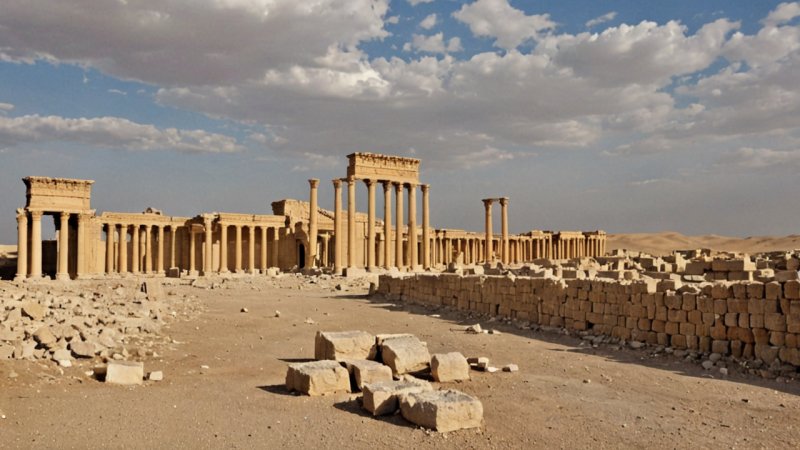The Middle East is a region rich in history and culture, often celebrated for its famous landmarks like the Pyramids of Giza and Petra. However, there exists a treasure trove of lesser-known ruins that offer unique insights into ancient civilizations and stunning architectural feats. In this article, we will compare two such hidden gems: the ruins of Palmyra in Syria and the ancient city of Hatra in Iraq. Both sites showcase fascinating histories and remarkable structures, yet they present distinct experiences for travelers seeking to uncover the secrets of the past.
Historical Background
Palmyra, known as the "Bride of the Desert," was an important city in ancient times, serving as a crucial trade hub connecting the East and West. It flourished during the Roman Empire and was renowned for its grand temples and colonnaded streets. In contrast, Hatra, an ancient city founded by the Parthians, is famed for its impressive fortifications and unique blend of Greek and Eastern architectural styles. Understanding the historical context of these ruins is essential in appreciating their significance.
Architectural Marvels
When it comes to architecture, both Palmyra and Hatra offer stunning visuals, yet they differ significantly in style. Palmyra is celebrated for its monumental structures, including the Temple of Bel and the Arch of Triumph, showcasing intricate carvings and towering columns that reflect Roman influence. The Colonnade, stretching for over a kilometer, is a breathtaking sight that transports visitors back to its heyday.
On the other hand, Hatra is distinguished by its massive walls and unique temples, including the Temple of Shamash, which features a circular design that is rare in ancient architecture. The city is surrounded by a 2.5-kilometer wall, providing a sense of grandeur and security. While Palmyra embodies the elegance of Roman architecture, Hatra represents a fusion of cultural influences, making each site a distinct architectural marvel.
Accessibility and Tourism
Accessibility is another important factor to consider when comparing these ruins. Palmyra, despite its remote location in the Syrian desert, has been a popular tourist destination, attracting visitors from around the world. However, ongoing conflicts in Syria have significantly impacted tourism, making it challenging to visit safely. Additionally, the site has suffered damage due to war, raising concerns about preservation.
Conversely, Hatra, located in northern Iraq, remains less frequented by tourists, partly due to safety concerns in the region. However, the lack of crowds offers a unique opportunity for visitors to explore the ruins in relative solitude, enhancing the experience of discovery. The government has made efforts to promote tourism in the area, and with improved security, Hatra is gradually becoming more accessible for adventurous travelers.
Unique Experiences
Visiting Palmyra offers a chance to immerse oneself in the history of a prominent ancient trade hub. Travelers can explore the ruins, learn about the city’s role in the Silk Road, and marvel at the remnants of its grand temples. The surrounding desert landscape adds to the mystique, providing stunning sunsets and a serene atmosphere.
In contrast, Hatra offers a more intimate experience with its less commercialized environment. The site allows visitors to appreciate the architectural uniqueness without the distractions often found at more popular tourist spots. An exploration of Hatra can lead to unexpected discoveries, such as intricate carvings and the city’s impressive fortifications, all while enjoying the tranquility of the surrounding landscape.
Preservation Efforts
Preservation is a critical aspect to consider when comparing these two sites. Palmyra has faced extensive damage due to conflict and vandalism, with many of its structures suffering irreparable harm. Efforts have been made by various organizations to restore and protect the site, but challenges remain due to ongoing instability in the region.
Hatra, while also affected by conflicts, has seen a stronger focus on preservation in recent years. The Iraqi government, alongside international organizations, is working to safeguard the ruins and promote the site as a cultural heritage destination. As a result, Hatra may offer a more hopeful future for preservation compared to Palmyra.
Conclusion
In conclusion, both Palmyra and Hatra represent incredible opportunities for travelers interested in exploring lesser-known ruins in the Middle East. Palmyra offers a glimpse into the grandeur of ancient trade and Roman architecture, while Hatra showcases a unique blend of cultural influences and impressive fortifications. Accessibility and preservation remain key considerations, with Hatra currently presenting a more viable option for visitors seeking a peaceful experience. Ultimately, both sites are invaluable pieces of history, and visiting either will enrich your understanding of the ancient world.






